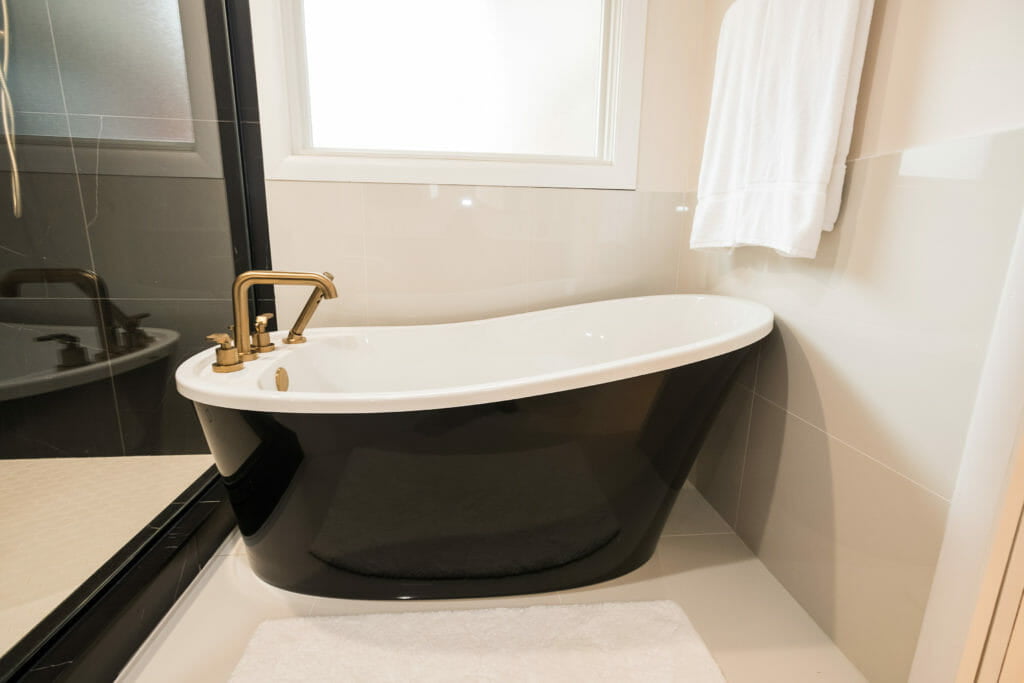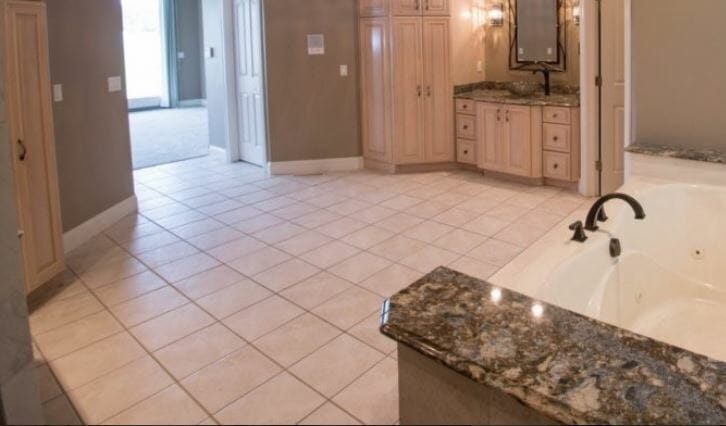What flooring material would be better for my bathroom and for the shower? Should I go for porcelain tiles, ceramic tiles or stone tiles? Which one would be more practical and durable? These are the questions I have in mind when I was planning to remodel my bathroom. I bet many people often wonder and ask themselves when creating their dream house.

At first glance, it’s tough to tell the difference between porcelain tiles and ceramic tiles. That’s because both of the products are very similar and they feel alike as well. They are both crafted from a similar process, but there are some key differences that are important to realize about these tile flooring options.
Ceramic Tile
Ceramic tiles are thin slabs of clay or other inorganic materials, hardened by oven firing and usually coated with some kind of glaze. Ceramic is best known for its durability, as you can see there are still intact installations in the ruins of ancient Rome and Egypt. There are many examples of beautiful ceramic tilework that are still pristine after 2,000 years.
Ceramic tile is a great choice for kitchens and bathrooms because it’s easy to clean and doesn’t harbor germs.
Porcelain Tile
Porcelain is a type of ceramic tile that is characterized by being stronger, harder, purer, and more water-resistant than ordinary ceramics which are already quite durable. It achieves this by using clays with finer particles, fired at a higher temperature that creates a harder glazed surface than is usually achieved by standard ceramic tiles.

Many people are aware that porcelain and ceramic tiles each have their own unique characteristics. What they cannot determine is what makes one better than the other, and here is the table to make simple and easy for you to remember on their pros and cons.
PORCELAIN TILES VERSUS CERAMIC TILES
| ADVANTAGES OF PORCELAIN | ADVANTAGES OF CERAMIC |
| Liquid Resistant – They are denser and less porous which makes them liquid resistant. This advantage can be increased through the application of a melted glass glaze, which will make any surface it is adhered to completely impervious to water. | Water Resistant – Ceramic tiles hold up well to moisture. Glazed ceramic flooring tiles have a hard protective top layer that makes the tiles impervious to water and most stains, making them naturally resistant to the ravages of high humidity conditions. |
| Durability – These are some of the toughest flooring options available. Hard, dense, and solid, porcelain is resistant to most heavy impact stresses, and can even be used in commercial environments. In general, this material should be classified with a PEI rating of at least 5, making it suitable for high-traffic spaces and heavy equipment use. | Durability – Ceramic flooring is extremely tough, and the tiles are difficult to crack. A quality installation can last for hundreds of years if the floor is well-maintained. If a single tile does crack due to a severe impact, the process of replacing a tile is relatively simple. |
| Stain Resistance – Porcelain tiles are dense, they are highly impervious to most substances and stains don’t have the chance to seep down in and set. | Design Options – Since dyes are added to ceramic tiles when they’re created, they are one of the most diverse tile flooring options out there. You can get these tiles in just about any color that you like, and they are sold in complex patterns as well if you’re looking for something more unique. |
| Low Maintenance – The natural stain and water resistance of porcelain also helps to make the material very easy to maintain. Periodic damp mopping with a solution of pH-balanced dish soap and water makes it easy to disinfect the area. | Allergens Issues – Ceramic tiles have a hard, solid surface, that does not attract or hold onto dirt, dust, pollen, or other allergens. When these small particles do land on a ceramic floor, they stand out against the surface, making it easy to wipe them away with a mop or sponge. This helps to keep the air free of irritating materials that can be harmful to asthma and allergy sufferers. |
| Fireproof – Porcelain does not burn under any normal conditions, and these floors can help to restrict the transference and movement of flames if a fire breaks out. | Coldness – While some tile holds heat fairly well, all tile gets cold in cold weather, which can be a shock to your toes first thing in the morning or an unwelcome reality on bare feet in the bathroom. The only way to counteract cold tile is with in-floor heat, either electric mats under the tile or radiant heating in or under the subfloor. |
| Cost – If properly installed and maintained, porcelain has the ability to last for decades of recommended use. This cuts down on the periodic cost of removal and replacement. | Cost – If cost is a big issue for you, ceramic tiles probably look like one of the best options for you to consider. This form of flooring is very affordable compared to something like porcelain. You’ll spend considerably less money on ceramic tile, and it will cost less to be installed as well. |
Stone Tile
Engineered stone tile (also known as agglomerate tile and aggregate tile) is made from bits of marble and other rock set in a base of epoxy. It comes in a wide variety of colors and designs. Because it’s man-made rather than hewn from natural stone, agglomerate tile has very precise, predictable measurements.

Pay attention to installation requirements; if the tile base is epoxy (resin), an epoxy must also be used for the setting material. Ultraviolet light from the sun can take the shine off the sealers used for agglomerate tile, says Daniel Dixon, a California-based tile construction expert. This makes agglomerate a better choice for indoor applications.
How Stone Tiles Are Made
There are slight variations in how various types of natural stone are quarried and shaped into tiles or countertops, but the process is similar for all the common types of stone, whether it is marble, granite, slate, limestone, or travertine. The example of how raw marble becomes a tile is a good example.
It took many steps involved and many hands touch a slab of stone, it is no wonder that marble and other natural stone is the most expensive surface you can choose for a bathroom. Still, there are reasons why stone is among the most desired of all remodeling materials.
Advantages of Stone
The principal advantage of marble and other natural stone in a bathroom is that it makes a bold statement of elegance and style. In centuries past, the stone was chosen as a building material because of its strength and durability, but in today’s construction, there are other building materials offer better strength and nearly equal durability—as well as lower cost. What hasn’t changed—and probably never will, since marble and other natural stone exist in limited supplies—is that natural stone symbolizes exclusivity and style.

The fact that natural stone is both expensive and unique means that using marble or other natural stone in your home almost automatically improves its resale value. Real estate agents will virtually always point out the presence of natural stone when selling a home, and prospective buyers always view it as a strong positive.
Some of the disadvantages of stone have now been reduced or eliminated by the development of chemical sealers that allow marble, granite, and other natural stone to be sealed against water and stains. The availability and effectiveness of these synthetic sealers are largely responsible for natural stone now being a viable material for wet locations such as bathrooms.

Disadvantages of Stone
For every advantage of natural stone, there are multiple disadvantages:
- More Expensive
- Stone is cold.
- Stone is slippery.
- Stone can be brittle.
- Stone floors may require structural adaptations.
- Natural stone is porous.
- Stone is more difficult to maintain.
- Stone is not a “green” material.
- Stone can be brittle.
- Stone floors may require structural adaptations.
- Natural stone is porous.
- Stone is more difficult to maintain.
- Stone is not a “green” material.
Now that we’ve discussed the pros and cons of Porcelain, Ceramic and Stone Tiles, you can move forward with your plans for the bathroom remodeling. You now have ideas which are the best tile to choose for your bathroom. But if you are still uncertain, you can contact the Ozarks Remodeling & Design. They give a five-part guarantee that would help you end up with the bathroom of your dreams without the construction nightmares.
>>>https://www.ozarksremodeling.com/consultation


